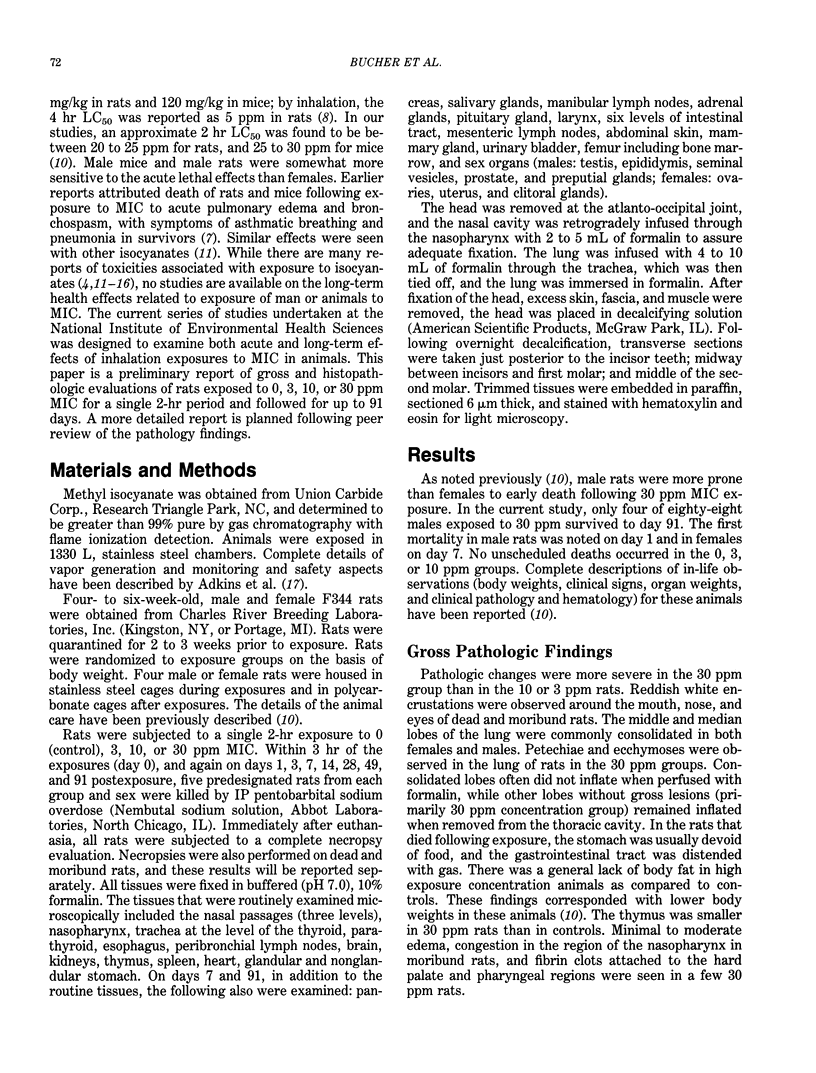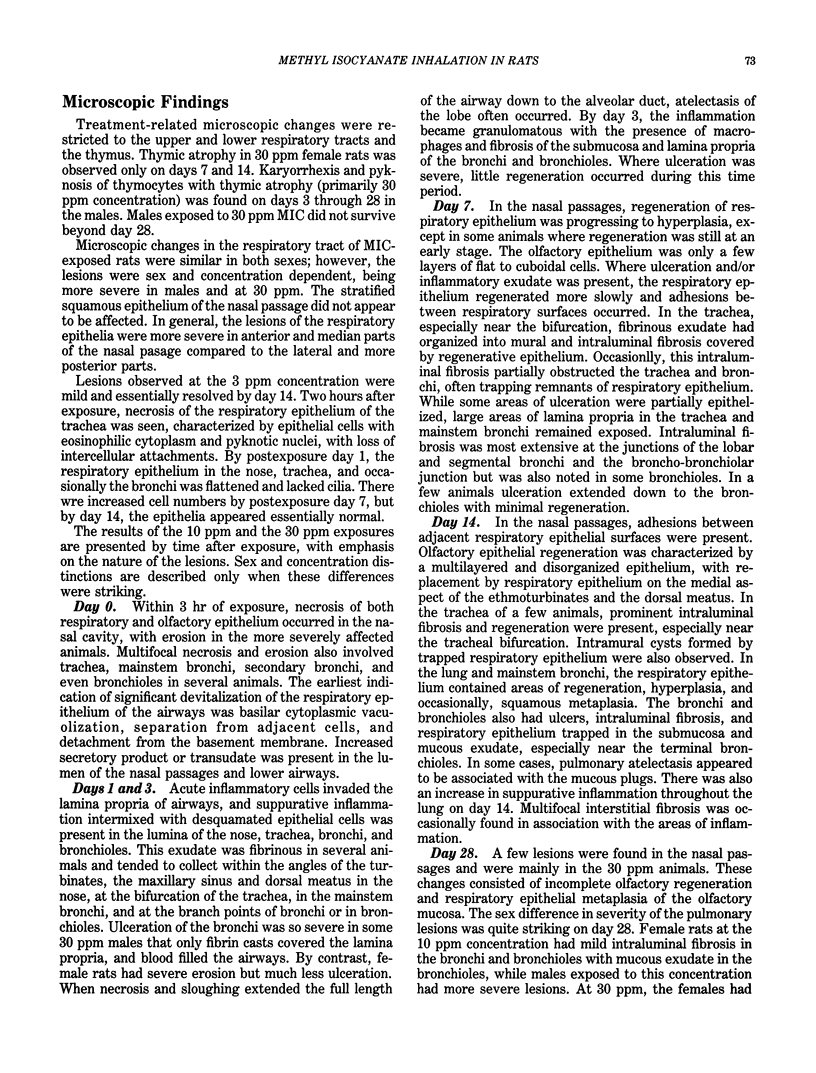Abstract
The accidental release of methyl isocyanate (MIC) in Bhopal, India, was reportedly responsible for the deaths of more than 2,000 people. To study the pathology of acute inhalation exposure to MIC, the tissues of male and female Fischer 344 rats were evaluated immediately after a single 2-hr exposure to 0, 3, 10, or 30 ppm MIC, and through day 91. Early gross pathologic changes in the 30 ppm-exposed rats included a reddish white encrustation around the mouth and nose, a small thymus, and distension of the gastrointestinal tract with gas. Lungs (middle and median lobes) showed consolidation and hemorrhage and failed to deflate when the chest cavity was opened. Microscopic changes in the upper respiratory tract 3 hr after exposure included marked erosion and separation of olfactory and respiratory epithelia from the basement membrane with accumulation of serofibrinous fluid. On day 1, acute inflammation and fibrinopurulent exudate partially blocked the nasal passages. Epithelial cells had sloughed from the nasopharynx, trachea, bronchi, and major bronchioles, leaving the basement membrane covered with fibrin and exudate. Granulomatous inflammation and intraluminal fibrosis of the airways were observed by day 3, with increased intraluminal fibrosis by day 7. Lower airways became blocked by exfoliated cells, mucous plugs, and/or intraluminal fibrosis.(ABSTRACT TRUNCATED AT 250 WORDS)
Full text
PDF




Selected References
These references are in PubMed. This may not be the complete list of references from this article.
- Adkins B., Jr, O'Connor R. W., Dement J. M. Inhalation exposure system used for acute and repeated-dose methyl isocyanate exposures of laboratory animals. Environ Health Perspect. 1987 Jun;72:45–51. doi: 10.1289/ehp.877245. [DOI] [PMC free article] [PubMed] [Google Scholar]
- Axford A. T., McKerrow C. B., Jones A. P., Le Quesne P. M. Accidental exposure to isocyanate fumes in a group of firemen. Br J Ind Med. 1976 May;33(2):65–71. doi: 10.1136/oem.33.2.65. [DOI] [PMC free article] [PubMed] [Google Scholar]
- Boorman G. A., Uraih L. C., Gupta B. N., Bucher J. R. Two-hour methyl isocyanate inhalation and 90-day recovery study in B6C3F1 mice. Environ Health Perspect. 1987 Jun;72:63–69. doi: 10.1289/ehp.877263. [DOI] [PMC free article] [PubMed] [Google Scholar]
- Bucher J. R., Gupta B. N., Adkins B., Jr, Thompson M., Jameson C. W., Thigpen J. E., Schwetz B. A. Toxicity of inhaled methyl isocyanate in F344/N rats and B6C3F1 mice. I. Acute exposure and recovery studies. Environ Health Perspect. 1987 Jun;72:53–61. doi: 10.1289/ehp.877253. [DOI] [PMC free article] [PubMed] [Google Scholar]
- Fowler E. H., Dodd D. E. Acute inhalation studies with methyl isocyanate vapor. II. Respiratory tract changes in guinea pigs, rats, and mice. Fundam Appl Toxicol. 1986 May;6(4):756–771. doi: 10.1016/0272-0590(86)90188-0. [DOI] [PubMed] [Google Scholar]
- Gupta B. N., Stefanski S. A., Bucher J. R., Hall L. B. Effect of methyl isocyanate (MIC) gas on the eyes of Fischer 344 rats. Environ Health Perspect. 1987 Jun;72:105–108. doi: 10.1289/ehp.8772105. [DOI] [PMC free article] [PubMed] [Google Scholar]
- HAMA G. M. Symptoms in workers exposed to isocyanates; suggested exposure concentrations. AMA Arch Ind Health. 1957 Sep;16(3):232–233. [PubMed] [Google Scholar]
- KIMMERLE G., EBEN A. ZUR TOXICITAET VON METHYLISOCYANAT UND DESSEN QUANTITATIVER BESTIMMUNG IN DER LUFT. Arch Toxikol. 1964 May 27;20:235–241. [PubMed] [Google Scholar]
- Kamat S. R., Mahashur A. A., Tiwari A. K., Potdar P. V., Gaur M., Kolhatkar V. P., Vaidya P., Parmar D., Rupwate R., Chatterjee T. S. Early observations on pulmonary changes and clinical morbidity due to the isocyanate gas leak at Bhopal. J Postgrad Med. 1985 Apr;31(2):63–72. [PubMed] [Google Scholar]
- Le Quesne P. M., Axford A. T., McKerrow C. B., Jones A. P. Neurological complications after a single severe exposure to toluene di-isocyanate. Br J Ind Med. 1976 May;33(2):72–78. doi: 10.1136/oem.33.2.72. [DOI] [PMC free article] [PubMed] [Google Scholar]
- Musk A. W., Peters J. M., DiBerardinis L., Murphy R. L. Absence of respiratory effects in subjects exposed to low concentrations of TDI and MDI. J Occup Med. 1982 Oct;24(10):746–750. [PubMed] [Google Scholar]
- Nemery B., Dinsdale D., Sparrow S., Ray D. E. Effects of methyl isocyanate on the respiratory tract of rats. Br J Ind Med. 1985 Dec;42(12):799–805. doi: 10.1136/oem.42.12.799. [DOI] [PMC free article] [PubMed] [Google Scholar]
- Rye W. A. Human responses to isocyanate exposure. J Occup Med. 1973 Mar;15(3):306–307. [PubMed] [Google Scholar]
- SWENSSON A., HOLMQUIST C. E., LUNDGREN K. D. Injury to the respiratory tract by isocyanates used in making lacquers. Br J Ind Med. 1955 Jan;12(1):50–53. doi: 10.1136/oem.12.1.50. [DOI] [PMC free article] [PubMed] [Google Scholar]
- Stevens M. A., Fitzgerald S., Ménache M. G., Costa D. L., Bucher J. R. Functional evidence of persistent airway obstruction in rats following a two-hour inhalation exposure to methyl isocyanate. Environ Health Perspect. 1987 Jun;72:89–94. doi: 10.1289/ehp.877289. [DOI] [PMC free article] [PubMed] [Google Scholar]
- Uraih L. C., Talley F. A., Mitsumori K., Gupta B. N., Bucher J. R., Boorman G. A. Ultrastructural changes in the nasal mucosa of Fischer 344 rats and B6C3F1 mice following an acute exposure to methyl isocyanate. Environ Health Perspect. 1987 Jun;72:77–88. doi: 10.1289/ehp.877277. [DOI] [PMC free article] [PubMed] [Google Scholar]
- ZAPP J. A., Jr Hazards of isocyanates in polyurethane foam plastic production. AMA Arch Ind Health. 1957 Apr;15(4):324–330. [PubMed] [Google Scholar]


